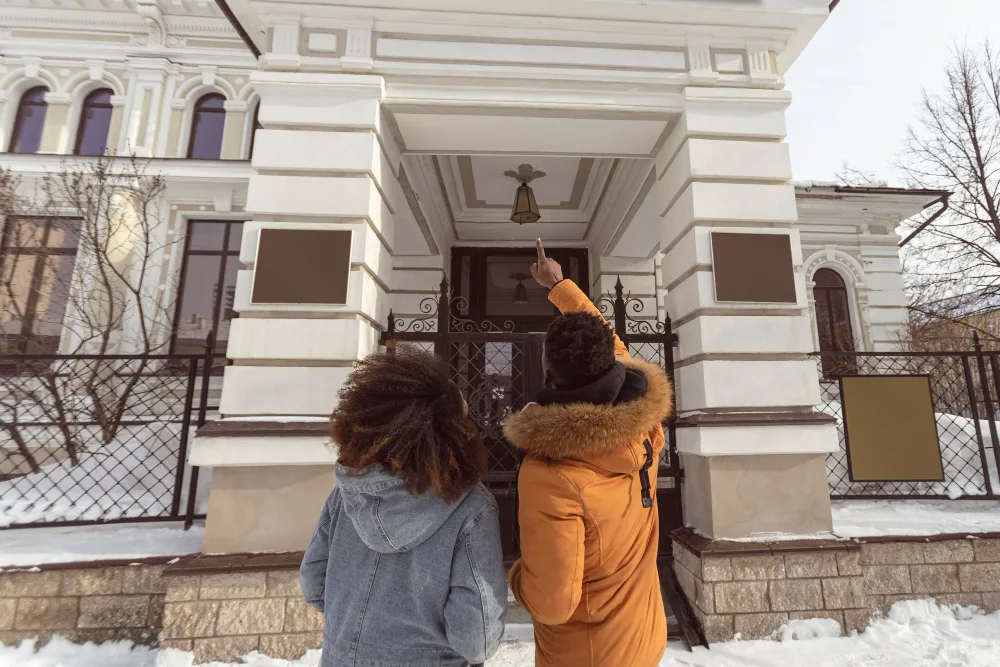Connecticut is home to some of the most beautiful historic homes in the country. These buildings are not just homes; they comprise historical texts revealing how the people worked and created their lives generations ago. From Colonial-era farmhouses to Victorian-era mansions, Connecticut’s historic houses give an insight into the past and enrich the present with character and charm.
If you fall into the category of those who have understood and appreciated the craftsmanship and ageless appeal of older homes, or if you’ve recently begun to ponder just what sets a historic home apart from the modern model, this guide is for you.
We will guide you through basically anything you would want to know about historic homes for sale in Connecticut, along with a buying and restoration guide, too.
Let’s get started.
Understanding Historic Homes in Connecticut
Connecticut has some incredible historic homes for sale that mix old-world character with the chance to make them your own. Whether you’re drawn to a cozy Cape Cod cottage or dreaming of a grand Victorian mansion, this state really does have something for every taste and wallet size.
Here’s what you’ll find out there:
- Colonial: These houses go way back to the 1600s, and people still love them for good reason. They’re beautifully simple. You’ll see those classic double-hung windows, tall brick chimneys, wooden clapboard siding, and front doors flanked by columns that just scream “welcome home.”
- Victorian: After the Civil War ended, these elaborate beauties took off and stayed popular until around 1900. You can’t miss them with all their fancy woodwork, towers poking up everywhere, and nothing quite matching on either side. People go crazy for the Gothic Revival ones, the Queen Anne style, or those charming Stick and Shingle varieties.
- Farmhouse: Built back in the 1700s by folks who needed homes that actually worked for their daily lives. You’ll love the big wraparound porches, perfect for summer evenings, dormer windows that let in tons of light, and sometimes even old barns that got connected to the main house. The newer ones often borrow ideas from Craftsman and Prairie styles.
- Cape Cod: New England fell in love with these compact gems in the early 1900s. They’re incredibly smart with space; those steep roofs shed snow like nobody’s business, dormer windows add charm and light, and every square foot gets used wisely. Perfect if you want character without needing a huge place.
Current Market OpportunitiesAs of April 2025, there are over 1915 vintage homes for sale across Connecticut. Many of these properties are located in desirable areas such as Greenwich, Stamford, and West Hartford. For buyers looking to purchase historic properties under $1 million, listings include charming Colonial-style homes in towns like Ridgefield ($985,000) or Victorian gems in Hamden ($490,000). |
Buying a Historic Home
Getting a historic home is nothing like buying a regular house. The charm pulls you in, but there’s a whole different world of things to think about.
Here’s what you need to know from the start.
1. What to Think About Before You Buy
Before you fall for that gorgeous 1800s Victorian, here’s what you’re really getting into:
- They control what you can change: Most old homes have some kind of historical commission watching over them. Want to paint your shutters a different color? Might need permission. Planning to add a deck? Better check with them first. Some people have had to repaint their entire house because they didn’t ask about the color first.
- Everything costs more to fix: When something breaks in an old house, you can’t just run to Home Depot. Finding someone who knows how to repair 1920s plaster walls properly can take months. And fixing those gorgeous but ancient windows? That’s a whole different price range.
- Get someone who knows old houses to look at it: Regular home inspectors miss stuff in historic homes. You need someone who understands knob-and-tube wiring, horsehair plaster, and all the weird things that made sense 100 years ago but could be problems now. Worth every penny to avoid nasty surprises later.
- Insurance companies get nervous: Try explaining to your insurance agent why your house has no central air, original hardwood floors, and a foundation made of fieldstone. Some companies won’t even touch historic homes. Others will charge you as if your house were made of matchsticks.
2. Steps to Purchase a Historic Home
Once you’ve decided that buying a historic home makes sense for you, here’s how to make the whole thing go smoother:
- Look around historic neighborhoods: Start checking out areas that have historic districts or homes on the National Register of Historic Places. These spots usually have the best selection.
- Figure out your money situation: Getting a loan for an old house isn’t always the same as a regular mortgage. Look into things like FHA 203(k) loans or renovation mortgages that let you roll the purchase price and fix-up costs into one payment. Really handy if the place needs major work.
- Learn the local rules: Every town has different rules about what you can and can’t do with historic properties. Check out zoning laws, easements, and any local rules that might mess with your renovation plans or how you want to use the house.
- Get it inspected properly: Don’t just get the basic inspection. Find people who know old houses inside and out – they’ll spot problems with the structure, dangerous materials like asbestos, or electrical systems that haven’t been updated since the Roosevelt administration.
Even though buying historic homes isn’t rocket science, there are enough tricky parts that you really want a Connecticut realtor who knows this stuff cold.
Kristin Egmont specializes in exactly these kinds of properties throughout Connecticut. She gets all the weird challenges that come with buying these houses, from dealing with preservation committees to figuring out what renovations will actually cost you. Having someone who knows the ropes can save you tons of headaches down the road.
3. Legal Stuff When Buying a Historic Home
When you’re buying an old house, there are a bunch of legal things that come with owning something tied to history. Here’s what you need to know, broken down so it actually makes sense:
- Preservation laws and what they mean for you
- Historic homes usually have protection laws at the local, state, or federal level. These laws make sure any changes you make keep the home’s historic character intact.
- If your house is in a historic district or marked as a landmark, you’ll probably need approval from local boards or historical groups before you change anything major.
- Zoning rules and what you can’t do
- Zoning laws might limit how you can use or change the property to keep its historic look and fit with the rest of the neighborhood.
- Things like changing the outside, redoing the landscaping, or turning it into a business might all need special approval.
- Easements and restrictions that stick around
- Easements are basically agreements that protect the property’s historical look by stopping certain changes, like tearing things down or changing the outside.
- These agreements come with the house forever, so even though you’re the new owner, you still have to follow them.
- Checking for dangerous stuff
- Older homes often have hazardous materials like lead paint, asbestos, or mold that can make you sick and cost a fortune to clean up properly.
- Some properties might also be in tricky spots like flood zones or wetlands, which could mess with any plans you have for future changes.
- Making old houses meet new safety rules
- Most historic homes don’t meet today’s building codes for safety and accessibility. When you renovate, you might need to update plumbing, wiring, or structural stuff while keeping the historical parts intact.
- Find contractors who know how to work on old houses so you stay legal without ruining what makes the house special.
Benefits of Buying a Historic HomeUnique Design and CraftsmanshipHeritage houses are filled with their own character and charm: stained glass windows, hardwood floors, or intricate moldings. These are found in the older homes and are missing in most new houses. It’s the labor and love that have gone into constructing the house that lend it its uniqueness, truly. A Connection to HistoryA historical house owns a shade of the past: these houses carry with them history, embedded stories, the very people of their residents, the community they share, and those with whom the house stood through the time it was built. To stay within them might be a source of pride and belonging for people, knowing they are securing their part of history for generations to come. Potential Tax BenefitsLots of historic houses have financial perks attached. Several of the programs go so far as to grant tax credits or reductions in property tax on an approved renovation to uphold the historic character of the home. All this would make owning a historic home even cheaper while providing an incentive to save the place. |
Restoring a Historic Home
After exploring everything about buying historic homes for sale in Connecticut, the next step is knowing the restoration tips.
It retains its charm while also meeting contemporary living standards. Restoration is more than just making repairs; it is about honoring the home’s history while keeping it functional and safe for today’s needs. This section will guide you through the process with restoration tips, helping you balance preservation with practicality.
1. Start with Research and Planning
Before beginning any restoration work, take this tip and research the home’s history and understand the rules that apply to its preservation.
- Understand preservation standards: Work must comply with the Secretary of the Interior’s Standards for Rehabilitation, which guide how historic properties can be restored without losing their significance.
- Consult local historical societies: They can provide valuable insights into your home’s architectural style and historical importance.
- Create a restoration plan: Prioritize structural repairs and safety updates while preserving original features.
2. Obtain Necessary Approvals
Restoration work on historic homes often requires permits and approvals to ensure compliance with preservation laws.
- Building permits: Any work visible from the street or requiring structural changes may need approval from local preservation commissions.
- State and federal reviews: If you’re using tax credits or grants, your plans must be reviewed by the State Historic Preservation Office (SHPO).
- Easements and covenants: Check if your property has restrictions that limit certain changes, such as altering facades or landscaping.
3. Preserve Original Features
The value of a historic home lies in its unique features, so focus on preserving them wherever possible.
- Repair over replace: Restore original woodwork, moldings, windows, and doors instead of replacing them with modern alternatives.
- Use authentic materials: Source materials that match the home’s original construction, such as period-appropriate bricks or timber.
- Preserve character-defining elements: Features like staircases, plasterwork, or fireplaces should be prioritized for conservation.
4. Address Structural and Safety Issues
Older homes often have hidden issues that must be addressed to ensure safety and longevity.
- Foundation and roof repairs: Stabilize the structure by fixing cracks or leaks.
- Electrical and plumbing updates: Replace outdated systems to meet modern safety codes while ensuring minimal impact on historical features.
- Hazardous materials removal: Lead paint, asbestos, or mold must be removed using approved methods that comply with preservation standards.
5. Thoughtful Modernization
Modernizing a historic home can improve comfort without compromising its character.
- Energy efficiency upgrades: Add insulation discreetly or install energy-efficient HVAC systems while maintaining aesthetics.
- Accessibility improvements: Use ADA-compliant designs that preserve historical integrity for features like ramps or doorways.
Financial Assistance for Restoration
Restoring historic homes for sale in Connecticut can be expensive, but several financial programs are available to help offset costs. Here are some key options available in Connecticut:
1. Tax Credits
The Connecticut Historic Rehabilitation Tax Credit Program offers:
- A 25% tax credit on qualified rehabilitation expenditures for certified historic structures.
- A higher 30% tax credit for projects located in federally designated opportunity zones or those that include affordable housing components.
- Eligible projects must comply with the Secretary of the Interior’s Standards for Rehabilitation, and costs incurred before approval are not eligible for credits.
2. Grants for Preservation Projects
The 1772 Foundation Matching Grants Program provides funding for specific restoration projects, such as:
- Exterior painting and surface restoration.
- Repairs to porches, roofs, windows, foundations, and chimneys.
- Fire detection, lightning protection, and security systems.
Grants are offered as 1:1 matching funds of up to $10,000 and are available to eligible non-profit organizations with a 501(c)(3) designation.
3. Rehabilitation Loans
The FHA 203(k) Loan Program combines the cost of purchasing and restoring a home into one loan, making it easier to finance renovations. Key features include:
- Coverage for structural repairs or energy-efficient upgrades.
- Options for both minor cosmetic updates and major structural renovations.
- Loans are available to homeowners looking to restore properties while meeting modern safety codes.
Historic Homes for Sale in Connecticut
Explore a selection of historic homes for sale in Connecticut. Whether you’re searching for a grand estate or a charming Colonial, Connecticut offers a wide variety of historic properties to suit your needs.
| Classic Victorian in Historic South Windsor
Price: $799,000 Location: 1063 Main St, South Windsor, CT 06074 Bedrooms: 9 | Bathrooms: 3 | Square Footage: 3,834 Description: A grand Victorian home offering both original details and modern conveniences. |
Stunning Greenwich Home on 11 Acres
Price: $10,995,000 Location: 188 Round Hill Road, Greenwich, CT 06831 Bedrooms: 7 | Bathrooms: 6 | Square Footage: 6,966 Description: A majestic estate set on 11 acres with views, privacy, and history. |
| Captivating & Elegant C. 1745 Colonial with Stunning Gardens
Price: $595,000 Location: 248 Main Street, Durham, CT 06422 Bedrooms: 4 | Bathrooms: 3 | Square Footage: 2,417 Description: This Colonial-style home is located in a historic district and features gorgeous gardens. |
Elegant Riverside Home on Nearly 2 Acres
Price: $6,495,000 Bedrooms: 5 | Bathrooms: 5.1 | Square Footage: 7,142 Description: A beautiful riverside estate that captures the essence of both luxury and historic character. |
| Fabulous Home on Award-Winning Grounds
Price: $4,495,000 Location: 30 Main Street, Essex, CT 06426 Bedrooms: 4 | Bathrooms: 4.5 | Square Footage: 3,488 Description: Set on beautifully landscaped grounds, this home blends elegance with history. |
Pre-Revolutionary Colonial Home
Price: $1,675,000 Location: 579 Taugwonk Rd, Stonington, CT 06378 Bedrooms: 5 | Bathrooms: 5 | Square Footage: 4,124 Description: A stunning colonial home with timeless charm and modern amenities. |
Ready to Make Your Historic Home Dream a Reality?
Purchasing a historic home is a once-in-a-lifetime and worthwhile experience, yet one that calls for proper know-how and professionalism to ensure it all goes off without a hitch. With over 20 years of experience, Kristin Egmont is extremely well-versed in the method and process for buying, selling, and renovating historic homes in Connecticut.
Are you ready to see the beauty of Connecticut’s historic homes? From homes for sale in Fairfield, CT, Darien, CT, Westport, and beyond. Reach out today, and let Kristin help you find your perfect property or guide you through the restoration process.




